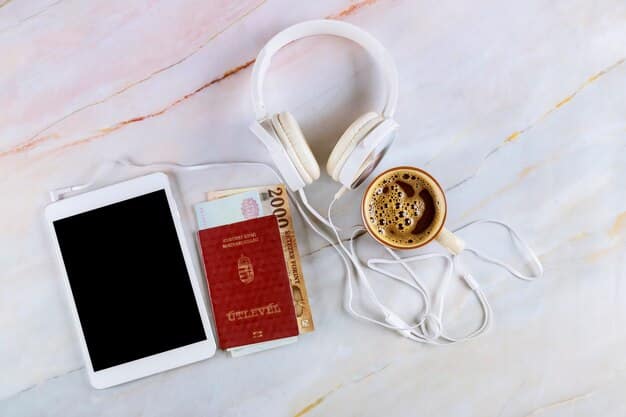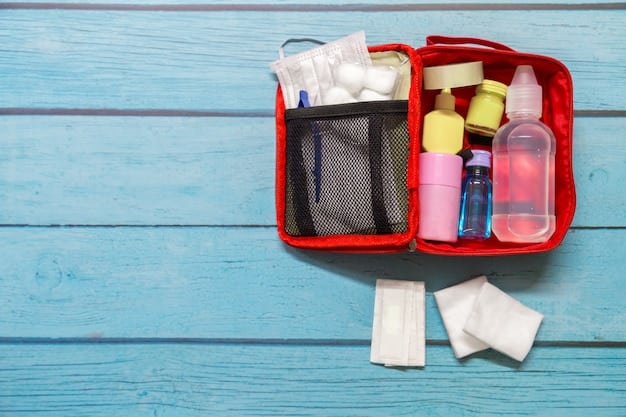The Ultimate Japan Packing List for US Tourists: What to Bring

The ultimate Japan packing list for US tourists ensures you’re prepared for your trip by carefully selecting essentials like comfortable shoes, necessary medications, and appropriate clothing, while leaving behind unnecessary items to travel light and efficiently.
Planning a trip to Japan from the US? Packing smart is crucial for an enjoyable experience. This guide, the ultimate Japan packing list for US tourists, will help you decide what to bring and what to leave behind, ensuring you’re prepared for everything from bustling cityscapes to serene temples.
Essential Documents and Travel Gear
Traveling internationally requires careful attention to your documents and essential gear. Ensuring you have everything in order before you leave can save you from unnecessary stress during your trip. From your passport to travel adapters, these items are non-negotiable.
Passport and Visas
Your passport should be valid for at least six months beyond your intended stay. Check visa requirements well in advance, as US citizens typically don’t need a visa for short-term tourist visits to Japan. Keep a digital copy of your passport stored securely online.
Travel Adapters and Converters
Japan uses Type A and B plugs with a voltage of 100V. US appliances operate on 120V, so you’ll need a travel adapter. Check if your devices are dual voltage; if not, a voltage converter is also necessary to prevent damage.

- Passport: Valid for at least six months after your return date.
- Travel Adapters: Essential for charging your devices.
- Portable Charger: Keep your devices powered on the go.
- Copies of Important Documents: Store separately from the originals.
Having these documents and gear ensures you can navigate Japan without communication barriers or technological mishaps. Being prepared also eases any concerns about entering the country legally.
Clothing and Footwear
The right clothing can significantly impact your comfort and enjoyment while traveling in Japan. Consider the season, planned activities, and local customs when selecting what to pack. Comfortable and versatile clothing is key.
Seasonal Considerations
Japan experiences four distinct seasons. Pack layers for spring and autumn, lightweight and breathable fabrics for summer, and warm, insulated clothing for winter. Research the average temperatures for your travel dates.
Comfortable Footwear
You’ll likely do a lot of walking, so prioritize comfortable shoes. Opt for cushioned sneakers or walking shoes. Bringing an extra pair of shoes or sandals can also be useful, especially for occasions where you might need to remove your shoes, like visiting temples or traditional restaurants.
- Walking Shoes: Comfortable and supportive for long days.
- Lightweight Jacket: Versatile for different weather conditions.
- Moisture-Wicking Socks: Keep your feet dry and comfortable.
- Versatile Outfit: A neutral outfit that can be dressed up or down.
Packing appropriately for different seasons and ensuring you have comfortable footwear are crucial. Careful planning in this area ensures you are ready for any weather.
Health and Personal Care
Maintaining your health and personal hygiene while traveling is essential. Packing the right health and personal care items ensures you’re prepared for any situation and can easily manage your routine away from home. It is crucial to bring items that you depend on.
Medications and First Aid
Bring any prescription medications you need, along with a copy of your prescription. Pack a basic first-aid kit with essentials like pain relievers, antiseptic wipes, and band-aids. Don’t forget any allergy medications or personal hygiene products that you prefer.
Personal Hygiene Products
While you can buy most personal care items in Japan, it’s convenient to bring travel-sized versions of your favorites. Consider packing sunscreen, insect repellent, and hand sanitizer, especially if you plan to spend time outdoors. If you have specific needs, pack them.

- Prescription Medications: Bring an adequate supply for your trip.
- First-Aid Kit: Include pain relievers, bandages, and antiseptic wipes.
- Sunscreen: Protect your skin from the sun.
- Hand Sanitizer: Keep your hands clean on the go.
Packing health and personal care is important for your well being. Be conscious and pack the items that will best suit you during your travel.
Electronics and Gadgets
In today’s digital age, electronics are indispensable for travel. Ensure you have the necessary gadgets and accessories to stay connected, entertained, and capture your experiences. These tools can greatly enhance your journey.
Smartphone and Camera
A smartphone is essential for navigation, communication, and accessing travel apps. Bring a good camera or use your smartphone to capture photos and videos of your trip. Consider a portable charger to keep your devices powered throughout the day.
Portable Wi-Fi Router
Staying connected is crucial for many travelers. Renting a portable Wi-Fi router ensures you have internet access wherever you go. Alternatively, purchase a local SIM card for your smartphone to access data services.
Japan’s technological landscape is advanced, and having the right tools ensures you can fully integrate and benefit from it. Properly equipped, you can easily navigate, communicate, and document your journey.
Money and Finances
Managing your finances wisely is crucial for a smooth trip to Japan. Understanding the local currency, payment methods, and exchange rates will help you budget effectively and avoid unnecessary fees. Having access to your finances is key.
Cash vs. Credit Cards
While credit cards are accepted at many establishments, especially in larger cities, Japan is still a cash-based society. Carry a mix of cash and credit cards. Inform your bank of your travel plans to avoid any issues with your cards.
Currency Exchange
Exchange some currency before you travel or upon arrival at the airport. ATMs are readily available, but check if they accept international cards. Look for ATMs at post offices and convenience stores like 7-Eleven.
- Japanese Yen: Carry enough cash for smaller establishments.
- Credit Cards: Inform your bank of your travel dates.
- Travel Budget: Plan your expenses to avoid overspending.
- Emergency Funds: Set aside money for unexpected situations.
Prudent financial management contributes significantly to a stress-free trip. Knowing how to access and manage your money allows you to fully enjoy your experiences without financial worries.
Things to Leave Behind
Knowing what not to bring is as important as knowing what to pack. Leaving behind unnecessary items will save you space, weight, and potential hassle. Pack smart by leaving behind bulky items.
Excessive Clothing
Avoid overpacking clothes. Bring versatile pieces that can be mixed and matched. Laundry services are readily available in Japan, so you don’t need to pack for every possible scenario. Leave behind items that you may only wear only once.
Bulky Guidebooks
Instead of carrying heavy guidebooks, download digital versions or use travel apps. These resources offer up-to-date information and save valuable space in your luggage. Keep your luggage light so it will be easier to carry.
- Unnecessary Gadgets: Only bring essential electronics.
- Heavy Toiletries: Purchase travel-sized versions or buy them in Japan.
- Expensive Jewelry: Avoid bringing valuables that could be lost or stolen.
- Duplicate Items: Streamline your packing by eliminating duplicates.
By being selective and leaving behind unnecessary items, you can travel lighter, more efficiently, and with less stress. This mindful approach ensures you only bring what you truly need for an enjoyable trip.
| Key Item | Brief Description |
|---|---|
| 🛄 Passport | Valid for six months, plus copies. |
| 👟 Comfortable Shoes | Essential for all the walking. |
| 💊 Medications | Prescriptions and basic first aid. |
| 📱 Travel Adapter | To charge devices without issues. |
FAQ
▼
You’ll need a Type A or Type B adapter for Japan. These are the same types used in North America, but Japan operates on 100V, so also check if your devices are dual-voltage or require a converter.
▼
Exchanging some currency before you go is a good idea. You can also exchange money at the airport upon arrival. Using ATMs once you’re there, especially at post offices and 7-Eleven stores, is another convenient, safe option.
▼
Pack clothing appropriate for the season. Layers are helpful for unpredictable weather. Comfortable walking shoes are crucial, as you’ll likely be doing a lot of walking and dress modestly, especially when visiting temples.
▼
Credit cards are becoming more widely accepted, especially in larger cities and tourist areas. However, smaller establishments and some rural areas still prefer cash. It’s best to carry a mix of both for convenience.
▼
Yes, bringing a small first-aid kit is a good idea. Include essentials like pain relievers, bandages, antiseptic wipes, and any personal medications you require. It’s always better to be overprepared when it comes to your health.
Conclusion
By following this comprehensive packing list, you’ll be well-prepared for your trip to Japan. From essential documents to comfortable clothing and the right electronics, packing smart ensures a smoother, more enjoyable travel experience. Consider this your ultimate guide to packing light and efficiently for your journey to Japan.





